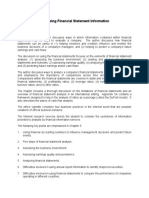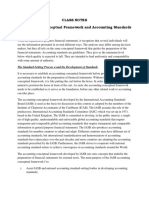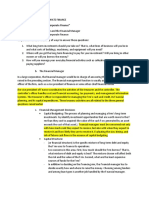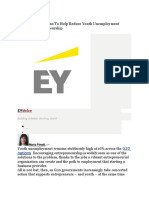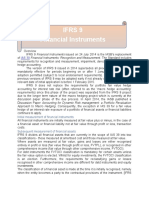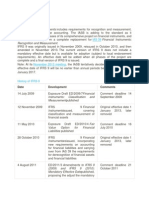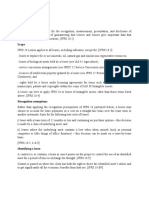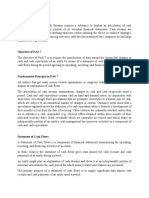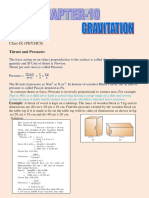IFRS 9 Summary
Overview
IFRS 9 Financial Instruments issued on 24 July 2014 is the IASB's substitution of IAS 39
Financial Instruments: Recognition and Measurement. The Standard incorporates prerequisites
for recognition and measurement, impairment, derecognition, and general hedge accounting. The
IASB completed its project to replace IAS 39 in phases, including the standard because it
completed each phase.
The version of IFRS 9 issued in 2014 supersedes all past forms and is mandatorily compelling
for periods starting on or after 1 January 2018 with early adoption permitted (subject to nearby
endorsement prerequisites). For a restricted period, past versions of IFRS 9 may be adopted early
if not already done so provided the important date of introductory application is sometime
recently 1 February 2015.
IFRS 9 does not supplant the prerequisites for portfolio fair value hedge accounting for intrigued
rate hazard (frequently referred to as the ‘macro hedge accounting’ prerequisites) since this stage
of the venture was isolated from the IFR.
Initial measurement of financial instruments
All financial instruments are initially measured at fair value plus or minus, within the case of a
financial asset or financial liability not at fair value through profit or loss, exchange costs. [IFRS
9, passage 5.1.1]
Subsequent measurement of financial assets
IFRS 9 separates all financial assets that are right now within the scope of IAS 39 into two
classifications - those measured at amortized cost and those measured at a fair value.
Where assets are measured at fair value, gains and losses are either recognized totally in profit or
loss (fair value through profit or loss, FVTPL) or recognized in other comprehensive salaries
(fair value through other comprehensive income, FVTOCI).
For debt instruments, the FVTOCI classification is mandatory for certain assets unless the fair
value option is chosen. Whilst for equity investments, the FVTOCI classification is an election.
Moreover, the prerequisites for reclassifying gains or losses recognized in other comprehensive
income are diverse for debt instruments and equity investments.
The classification of a financial asset is made at the time it is first recognized, specifically when
the entity becomes a party to the contractual provisions of the instrument. [IFRS 9, section 4.1.1]
If certain conditions are met, the classification of an asset may subsequently need to be
reclassified.
Debt Instruments
�A debt instrument that meets the following two conditions must be measured at amortized cost
(net of any compose down for impairment) unless the asset is assigned at FVTPL under the fair
value option:
[IFRS 9, paragraph 4.1.2]
Business model test: The objective of the entity's business model is to hold the financial
asset to gather the contractual cash flows (instead of offering the instrument prior to its
contractual maturity to figure out its reasonable esteem changes).
Cash flow characteristics test: The contractual terms of the financial asset grant rise on
indicated dates to cash flows that are exclusively payments of principal and interest on the
principal amount outstanding.
Evaluating the cash flow characteristics also incorporates an analysis of changes within the
timing or within the number of payments. It is necessary to assess whether the cash flows before
and after the change represent only repayments of the nominal amount and an interest rate based
on them.
The right of termination may for example be in agreement with the cash flow condition if, within
the case of termination, the only outstanding payments comprise of principal and interest on the
principal amount and an appropriate compensation payment where applicable. In October 2017,
the IASB clarified that the compensation payments can moreover have a negative sign.
[IFRS 9, paragraph 4.1.2A]
Business model test: The financial asset is held within a business model whose objective
is accomplished by both collecting contractual cash flows and selling financial assets.
Cash flow characteristics test: The contractual terms of the financial asset give rise on
specified dates to cash flows that are exclusively payments of principal and interest on the
principal amount outstanding.
Fair value option
Even if an instrument meets the two prerequisites to be measured at amortized cost or FVTOCI,
IFRS 9 contains a choice to assign, at initial recognition, a financial asset as measured at FVTPL
if doing so eliminates or significantly reduces a measurement or recognition inconsistency (in
some cases referred to as an 'accounting mismatch') that would otherwise arise from measuring
assets or liabilities or recognizing the gains and losses on them on different bases. [IFRS 9,
passage 4.1.5]
Equity Instruments
All equity investments in the scope of IFRS 9 are to be measured at fair value in the statement of
financial position, with value changes recognized in profit or loss, but for those equity
investments for which the entity has elected to display value changes in other comprehensive
income'. There's no 'cost exception' for unquoted equities.
�Other comprehensive income option
If an equity investment isn't held for exchanging, an entity can make an irreversible election at
initial recognition to measure it at FVTOCI with only dividend salary recognized in profit or
loss. [IFRS 9, section 5.7.5]
Measurement guidance
In spite of the fair value prerequisite for all equity investments, IFRS 9 contains guidance on
when the cost may be the best estimate of fair value additionally when it might not be
representative of fair value.
Subsequent measurement of financial liabilities
IFRS 9 doesn't change the basic accounting model for financial liabilities under IAS 39. Two
measurement categories continue to exist: FVTPL and amortized cost. Financial liabilities held
for exchanging are measured at FVTPL, and all other financial liabilities are measured at
amortized cost unless the fair value option is applied. [IFRS 9, section 4.2.1]
Derecognition of financial assets
An asset is transferred if either the entity has transferred the contractual rights to receive the cash
flows, or the entity has retained the contractual rights to receive the cash flows from the asset,
but has assumed a contractual obligation to pass those cash flows on under an arrangement that
meets the following three conditions: [IFRS 9, paragraphs 3.2.4-3.2.5] the entity has no
obligation to pay amounts to the eventual recipient unless it collects equivalent amounts on the
original asset the entity is prohibited from selling or pledging the original asset (other than as
security to the eventual recipient), the entity has an obligation to remit those cash flows without
material delay Once an entity has determined that the asset has been transferred, it then
determines whether or not it has transferred substantially all of the risks and rewards of
ownership of the asset.
Derecognition of financial liabilities
[IFRS 9, paragraph 3.3.1] Where there has been an exchange between an existing borrower and
lender of debt instruments with substantially different terms, or there has been a substantial
modification of the terms of existing financial liability, this transaction is accounted for as an
extinguishment of the original financial liability and the recognition of a new financial liability.
Derivatives
All derivatives in the scope of IFRS 9, including those connected to unquoted equity
investments, are measured at fair value. Value changes are recognized in profit or loss unless the
entity has elected to apply hedge accounting by assigning the derivative as a hedging instrument
in an eligible hedging relationship.
Embedded Derivatives
�The embedded derivative guidance that existed in IAS 39 is included in IFRS 9 to help preparers
identify when an embedded derivative is closely related to a financial liability host contract or a
host contract not within the scope of the Standard (e.g. leasing contracts, insurance contracts,
contracts for the purchase or sale of a non-financial items).
Reclassification
For financial assets, reclassification is required between FVTPL, FVTOCI, and amortized cost, if
and only if the entity's business model objective for its financial assets changes so its previous
model assessment would no longer apply.
Hedge Accounting
When an entity first applies IFRS 9, it may choose as its accounting policy choice to continue to
apply the hedge accounting requirements of IAS 39 instead of the requirements of Chapter 6 of
IFRS 9 [IFRS 9 paragraph 7.2.21] Qualifying criteria for hedge accounting A hedging
relationship qualifies for hedge accounting only if all of the following criteria are met: the
hedging relationship consists only of eligible hedging instruments and eligible hedged items.
Fair value hedge: a hedge of the exposure to changes in fair value of a recognized asset or
liability or an unrecognized firm commitment, or a component of any such thing, that's inferable
to a particular risk and could affect profit or loss (or OCI within the case of an equity instrument
assigned as at FVTOCI). [IFRS 9 passages 6.5.2(a) and 6.5.3]
For a fair value hedge, the gain or loss on the hedging instrument is recognized in profit or loss
(or OCI, if hedging an equity instrument at FVTOCI and the hedging gain or loss on the hedged
item adjusts the carrying amount of the hedged thing and is recognized in profit or loss. In any
case, if the hedged thing is an equity instrument at FVTOCI, those sums stay in OCI. When a
hedged item is an unrecognized firm commitment the cumulative hedging gain or loss is
recognized as an asset or a liability with a corresponding gain or loss recognized in profit or loss.
[IFRS 9 passage 6.5.8]
Cash flow hedge: a hedge of the presentation to variability in cash flows that are inferable to a
specific risk related with all, or a component of, a recognized asset or liability (such as all or a
few future interest payments on variable-rate debt) or an exceedingly probable forecast
exchange, and may influence profit or loss. [IFRS 9 passage 6.5.2(b)]
For a cash flow hedge, the cash flow hedge save in value is balanced to the lower of the
following (in absolute amounts):
> the cumulative gain or loss on the hedging instrument from the inception of the hedge;
and
> the cumulative change in fair value of the hedged thing from the inception of the hedge.
The portion of the gain or loss on the hedging instrument that's decided to be an effective hedge
is perceived in OCI and any remaining gain or loss is hedge incapability that's recognised in
profit or loss.
�In case a hedged forecast exchange hence comes about within the recognition of a non-financial
item or gets to be a firm commitment for which fair value hedge accounting is applied, the
amount that has been collected within the cash flow hedge reserve is removed and included
straightforwardly within the initial cost or other carrying sums of the asset or the liability. In
other cases, the amount that has been collected within the cash flow hedge reserve is reclassified
to profit or loss within the same period(s) as the hedged cash flows affect profit or loss. [IFRS 9
passage 6.5.11]
When an entity suspends hedge accounting for a cash flow hedge, if the hedged future cash flows
are still anticipated to happen, the amount that has been gathered within the cash flow hedge
reserve remains there until the future cash flows happen; if the hedged future cash flows are no
longer anticipated to happen, that amount is quickly reclassified to profit or loss [IFRS 9 passage
6.5.12]
A hedge of the foreign currency risk of a firm commitment may be accounted for as a fair value
hedge or a cash flow hedge. [IFRS 9 passage 6.5.4]
A hedge of a net investment in a foreign operation (as characterized in IAS 21), including a
hedge of a money related thing that's accounted for as part of the net investment, is accounted for
similarly to cash flow hedges:
> the portion of the gain or loss on the hedging instrument that's determined to be a
successful hedge is recognized in OCI, and
> the ineffective portion is recognized in profit or loss. [IFRS 9 passage 6.5.13]
Hedge effectiveness requirements
In order to qualify for hedge accounting, the hedge relationship must meet the following viability
criteria at the starting of each hedged period:
> there is an economic relationship between the hedged thing and the hedging instrument;
> the impact of credit risk does not overwhelm the value changes that result from that
economic relationship; and
> the hedge ratio of the hedging relationship is the same as that really used within the
economic hedge [IFRS 9 passage 6.4.1(c)]
Rebalancing and discontinuation
If a hedging relationship ceases to meet the hedge effectiveness requirement relating to the hedge
ratio but the risk management objective for that designated hedging relationship remains the
same, an entity adjusts the hedge ratio of the hedging relationship (i.e. rebalances the hedge) so
that it meets the qualifying criteria again.
An entity discontinues hedge accounting prospectively only when the hedging relationship (or a
part of a hedging relationship) ceases to meet the qualifying criteria (after any rebalancing).
�Discontinuing hedge accounting can either affect a hedging relationship in its entirety or only a
part of it (in which case hedge accounting continues for the remainder of the hedging
relationship).
Time value of options
When an entity separates the intrinsic value and time value of an option contract and designates
as the hedging instrument only the change in the intrinsic value of the option, it recognizes some
or all of the change in the time value in OCI which is later removed or reclassified from equity as
a single amount or on an amortized basis (depending on the nature of the hedged item) and
ultimately recognized in profit or loss.
Forward points and foreign currency basis spreads
When an entity separates the forward points and the spot element of a forward contract and
designates as the hedging instrument only the change in the value of the spot element, or when
an entity excludes the foreign currency basis spread from a hedge the entity may recognize the
change in the value of the excluded portion in OCI to be later removed or reclassified from
equity as a single amount or on an amortized basis (depending on the nature of the hedged item)
and ultimately recognized in profit or loss.
Credit exposures designated at FVTPL
If designated after initial recognition, any difference in the previous carrying amount and fair
value is recognized immediately in profit or loss. An entity discontinues measuring the financial
instrument that gave rise to the credit risk at FVTPL if the qualifying criteria are no longer met
and the instrument is not otherwise required to be measured at FVTPL.
If an entity uses a credit derivative measured at FVTPL to manage the credit risk of a financial
instrument (credit exposure) it may designate all or a proportion of that financial instrument as
measured at FVTPL if: the name of the credit exposure matches the reference entity of the credit
derivative (‘name matching’); and the seniority of the financial instrument matches that of the
instruments that can be delivered in accordance with the credit derivative.
Impairment
The impairment model in IFRS 9 is based on the premise of providing for expected losses.
Scope
IFRS 9 requires that the same impairment model applies to all of the following: [IFRS 9
paragraph 5.5.1] Financial assets measured at amortized cost; Financial assets mandatorily
measured at FVTOCI; Loan commitments when there is a present obligation to extend credit
(except where these are measured at FVTPL); Financial guarantee contracts to which IFRS 9 is
applied (except those measured at FVTPL); Lease receivables within the scope of IAS 17
Leases; and Contract assets within the scope of IFRS 15 Revenue from Contracts with
Customers (i.e. rights to consider following the transfer of goods or services).
General Approach
�With the exception of purchased or originated credit-impaired financial assets (see below),
expected credit losses are required to be measured through a loss allowance at an amount equal
to: the 12-month expected credit losses (expected credit losses that result from those default
events on the financial instrument that are possible within 12 months after the reporting date); or
full lifetime expected credit losses (expected credit losses that result from all possible default
events over the life of the financial instrument).
A loss allowance for full lifetime expected credit losses is required for a financial instrument if
the credit risk of that financial instrument has increased significantly since initial recognition, as
well as to contract assets or trade receivables that do not constitute a financing transaction in
accordance with IFRS 15.
Significant increase in credit risk
IFRS 9 also requires that (other than for purchased or originated credit-impaired financial
instruments) if a significant increase in credit risk that had taken place since initial recognition
and has reversed by a subsequent reporting period (i.e., cumulatively credit risk is not
significantly higher than at initial recognition) then the expected credit losses on the financial
instrument revert to being measured based on an amount equal to the 12-month expected credit
losses.
With the exception of purchased or originated credit-impaired financial assets (see below), the
loss allowance for financial instruments is measured at an amount equal to lifetime expected
losses if the credit risk of a financial instrument has increased significantly since initial
recognition unless the credit risk of the financial instrument is low at the reporting date in which
case it can be assumed that credit risk on the financial instrument has not increased significantly
since initial recognition.
Purchased or originated credit-impaired financial assets
Under the requirements, any favorable changes for such assets are an impairment gain even if the
resulting expected cash flows of a financial asset exceed the estimated cash flows on initial
recognition. For these assets, an entity would recognize changes in lifetime expected losses since
initial recognition as a loss allowance with any changes recognized in profit or loss.
Credit-impaired financial asset
It includes observable data that has come to the attention of the holder of a financial asset about
the following events: [IFRS 9 Appendix A] the significant financial difficulty of the issuer or
borrower; a breach of contract, such as a default or past-due event; the lenders for economic or
contractual reasons relating to the borrower’s financial difficulty granted the borrower a
concession that would not otherwise be considered; it becoming probable that the borrower will
enter bankruptcy or other financial reorganization; the disappearance of an active market for the
financial asset because of financial difficulties; or the purchase or origination of a financial asset
at a deep discount that reflects incurred credit losses.
Basis for estimating expected credit losses
�Expected credit losses of undrawn loan commitments should be discounted by using the effective
interest rate (or an approximation thereof) that will be applied when recognizing the financial
asset resulting from the commitment.
In contrast to the “effective interest rate” (calculated using expected cash flows that ignore
expected credit losses), the credit-adjusted effective interest rate reflects expected credit losses of
the financial asset.
An entity may use practical expedients when estimating expected credit losses if they are
consistent with the principles in the Standard (for example, expected credit losses on trade
receivables may be calculated using a provision matrix where a fixed provision rate applies
depending on the number of days that a trade receivable is outstanding).
12-month expected credit losses represent the lifetime cash shortfalls that will result if a default
occurs in the 12 months after the reporting date, weighted by the probability of that default
occurring.
To reflect time value, expected losses should be discounted to the reporting date using the
effective interest rate of the asset (or an approximation thereof) that was determined at initial
recognition.
Also, the entity should consider reasonable and supportable information about past events,
current conditions, and reasonable and supportable forecasts of future economic conditions when
measuring expected credit losses.
Any measurement of expected credit losses under IFRS 9 shall reflect an unbiased and
probability-weighted amount that is determined by evaluating the range of possible outcomes as
well as incorporating the time value of money.
A “credit-adjusted effective interest” rate should be used for expected credit losses of purchased
or originated credit-impaired financial assets.
The Standard defines expected credit losses as the weighted average of credit losses with the
respective risks of a default occurring as the weightings.
In particular, for lifetime expected losses, an entity is required to estimate the risk of a default
occurring on the financial instrument during its expected life.
Presentation
In the case of a financial asset that is not a purchased or originated credit-impaired financial asset
but subsequently has become credit-impaired, interest revenue is calculated by applying the
effective interest rate to the amortized cost balance, which comprises the gross carrying amount
adjusted for any loss allowance.
In the case of a financial asset that is not a purchased or originated credit-impaired financial asset
and for which there is no objective evidence of impairment at the reporting date, interest revenue
is calculated by applying the effective interest rate method to the gross carrying amount.
�In the case of purchased or originated credit-impaired financial assets, interest revenue is always
recognized by applying the credit-adjusted effective interest rate to the amortized cost carrying
amount.
Consequential amendments of IFRS 9 to IAS 1 require that impairment losses, including
reversals of impairment losses and impairment gains (in the case of purchased or originated
credit-impaired financial assets), are presented in a separate line item in the statement of profit or
loss and other comprehensive income.
Disclosures
IFRS 9 amends some of the requirements of IFRS 7 Financial Instruments: Disclosures including
adding disclosures about investments in equity instruments designated as at FVTOCI, disclosures
on risk management activities, and hedge accounting, and disclosures on credit risk management
and impairment.
IAS 28 Summary
Overview
The standard also defines an associate by reference to the concept of "significant influence",
which requires power to participate in financial and operating policy decisions of an investee
(but not joint control or control of those policies).
IAS 28 Investments in Associates and Joint Ventures (as amended in 2011) outlines how to
apply, with certain limited exceptions, the equity method to investments in associates and joint
ventures.
Objective of IAS 28
The objective of IAS 28 (as amended in 2011) is to prescribe the accounting for investments in
associates and to set out the requirements for the application of the equity method when
accounting for investments in associates and joint ventures.
Scope
�IAS 28 applies to all entities that are investors with joint control of, or significant influence over,
an investee (associate or joint venture).
Significant Influence
The existence of significant influence by an entity is usually evidenced in one or more of the
following ways: representation on the board of directors or equivalent governing body of the
investee; participation in the policy-making process, including participation in decisions about
dividends or other distributions; material transactions between the entity and the investee;
interchange of managerial personnel; or provision of essential technical information The
existence and effect of potential voting rights that are currently exercisable or convertible,
including potential voting rights held by other entities, are considered when assessing whether an
entity has significant influence.
In assessing whether potential voting rights contribute to significant influence, the entity
examines all facts and circumstances that affect potential rights An entity loses significant
influence over an investee when it loses the power to participate in the financial and operating
policy decisions of that investee.
The Equity method of Accounting
Basic principle. Under the equity method, on initial recognition, the investment in an associate
or a joint venture is recognized at cost, and the carrying amount is increased or decreased to
recognize the investor's share of the profit or loss of the investee after the date of acquisition.
Distributions and other adjustments to carrying amount. The investor's share of the
investee's profit or loss is recognized within the investor's profit or loss. Dispersions received
from an investee diminish the carrying amount of the investment. Adjustments to the carrying
sum may moreover be necessary for changes within the investor's proportionate interest within
the investee arising from changes within the investee's other comprehensive income (e.g. to
account for changes emerging from revaluations of property, plant, and equipment and foreign
cash translations.)
Potential voting rights. An entity's interest in an associate or a joint venture is decided solely on
the basis of the existing ownership interests and, generally, does not reflect the conceivable
exercise or transformation of potential voting rights and other derivative disobedient.
Interaction with IFRS 9. An entity applies IFRS 9, including its impairment requirements, to
long-term interests in an associate or joint venture that form part of the net investment in the
associate or joint venture but to which the equity method is not applied. Instruments containing
potential voting rights in an associate or a joint venture are accounted for following IFRS 9
unless they currently give access to the returns associated with an ownership interest in an
associate or a joint venture. IFRS 9 Financial Instruments does not apply to interests in associates
and joint ventures that are accounted for using the equity method.
�Classification as non-current asset. An investment in an associate or a joint venture is
generally classified as a non-current asset, unless it is classified as held for sale in accordance
with IFRS 5 Non-current Assets Held for Sale and Discontinued Operations.
Application of the equity method of accounting
Basic Principle. In its consolidated financial statements, an investor uses the equity method of
accounting for investments in associates and joint ventures. Furthermore, the concepts
underlying the procedures used in accounting for the acquisition of a subsidiary are also adopted
in accounting for the acquisition of an investment in an associate or a joint venture. Many of the
procedures that are appropriate for the application of the equity method are similar to the
consolidation procedures described in IFRS 10.
Exemptions from applying the equity method. An entity is exempt from applying the equity
method if the investment meets one of the following conditions:
The entity is a parent that is exempt from preparing consolidated financial statements under IFRS
10 Consolidated Financial Statementsor or if all of the following four conditions are met (in
which case the entity need not apply the equity method): the entity is a wholly-owned subsidiary
or is a partially-owned subsidiary of another entity and its other owners, including those not
otherwise entitled to vote, have been informed about, and do not object to, the investor not
applying the equity method the investor or joint venturer's debt or equity instruments are not
traded in a public market the entity did not file, nor is it in the process of filing, its financial
statements with a securities commission or other regulatory organization to issue any class of
instruments in a public market, and the ultimate or any intermediate parent of the parent
produces financial statements available for public use that comply with IFRSs, in which
subsidiaries are consolidated or are measured at fair value through profit or loss under IFRS 10.
When an investment in an associate or a joint venture is held by or is held indirectly through, an
entity that is a venture capital organization, or a mutual fund, unit trust, and similar entities
including investment-linked insurance funds, the entity may elect to measure investments in
those associates and joint ventures at fair value through profit or loss under IFRS 9.
When an entity has an investment in an associate, a portion of which is held indirectly through a
venture capital organization, or a mutual fund, unit trust, and similar entities including
investment-linked insurance funds, the entity may elect to measure that portion of the investment
in the associate at fair value through profit or loss under IFRS 9 regardless of whether the
venture capital organization or the mutual fund, unit trust and similar entities including
investment-linked insurance funds, has significant influence over that portion of the investment.
If the entity makes that election, the entity shall apply the equity method to any remaining
portion of its investment in an associate that is not held through a venture capital organization, or
a mutual fund, unit trust, and similar entities including investment-linked insurance funds.
Classification as held for sale. Any remaining portion is accounted for using the equity method
until the time of disposal, at which time the retained investment is accounted under IFRS 9
unless the retained interest continues to be an associate or joint venture. When the investment, or
�portion of an investment, meets the criteria to be classified as held for sale, the portion so
classified is accounted for in accordance with IFRS 5.
Discontinuing the equity method. Use of the equity method should cease from the date that
significant influence or joint control ceases:
If the investment becomes a subsidiary, the entity accounts for its investment in accordance with
IFRS 3 Business Combinations and IFRS 10 If the retained interest is a financial asset, it is
measured at fair value and subsequently accounted for under IFRS 9 Any amounts recognized in
other comprehensive income in relation to the investment in the associate or joint venture are
accounted for on the same basis as if the investee had directly disposed of the related assets or
liabilities (which may require reclassification to profit or loss) If an investment in an associate
becomes an investment in a joint venture (or vice versa), the entity continues to apply the equity
method and does not remeasure the retained interest.
Changes in ownership interest. If an entity's interest in an associate or joint venture is reduced,
but the equity method is continued to be applied, the entity reclassifies to profit or loss the
proportion of the gain or loss previously recognized in other comprehensive income relative to
that reduction in ownership interest.
Equity method procedures
When applying the equity method to an associate or a joint venture, a non-investment entity
investor in an investment entity may retain the fair value measurement applied by the associate
or joint venture to its interests in subsidiaries.
The interest in an associate or joint venture is the carrying amount of the investment in the
associate or joint venture under the equity method together with any long-term interests that, in
substance, form part of the investor or joint venturer's net investment in the associate or joint
venture. Adjustments to the entity's share of the associate's or joint venture's profit or loss after
acquisition are made, for example, for depreciation of the depreciable assets based on their fair
values at the acquisition date or for impairment losses such as for goodwill or property, plant,
and equipment. On acquisition, any difference between the cost of the investment and the
entity’s share of the net fair value of the investee's identifiable assets and liabilities in case of
goodwill is included in the carrying amount of the investment (amortization not permitted), and
any excess of the entity's share of the net fair value of the investee's identifiable assets and
liabilities over the cost of the investment is included as income in the determination of the
entity's share of the associate or joint venture’s profit or loss in the period in which the
investment is acquired. In applying the equity method, the investor or joint venturer should use
the financial statements of the associate or joint venture as of the same date as the financial
statements of the investor or joint venturer unless it is impracticable to do so. If the associate or
joint venture uses accounting policies that differ from those of the investor, the associate or joint
venture's financial statements are adjusted to reflect the investor's accounting policies for the
purpose of applying the equity method. Profits and losses resulting from upstream (associate to
an investor, or joint venture to joint venturer) and downstream (investor to associate, or joint
venturer to the joint venture) transactions are eliminated to the extent of the investor's interest in
�the associate or joint venture. If an investor's or joint venturer's share of losses of an associate or
joint venture equals or exceeds its interest in the associate or joint venture, the investor or joint
venturer discontinues recognizing its share of further losses. If it is impracticable, the most
recently available financial statements of the associate or joint venture should be used, with
adjustments made for the effects of any significant transactions or events occurring between the
accounting period ends. An investment is accounted for using the equity method from the date on
which it becomes an associate or a joint venture. After the investor or joint venturer's interest is
reduced to zero, a liability is recognized only to the extent that the investor or joint venturer has
incurred legal or constructive obligations or made payments on behalf of the associate.
Contributions of non-monetary assets to an associate or joint venture in exchange for an equity
interest in the associate or joint venture are also accounted for in accordance with these
requirements.
Impairment. After application of the equity method, an entity applies IAS 39 Financial
Instruments: Recognition and Measurement to determine whether it is necessary to recognize any
additional impairment loss with respect to its net investment in the associate or joint venture.
Disclosure
There are no disclosures specified in IAS 28. Instead, IFRS 12 Disclosure of Interests in Other
Entities outlines the disclosures required for entities with joint control of, or significant influence
over, an investee.








